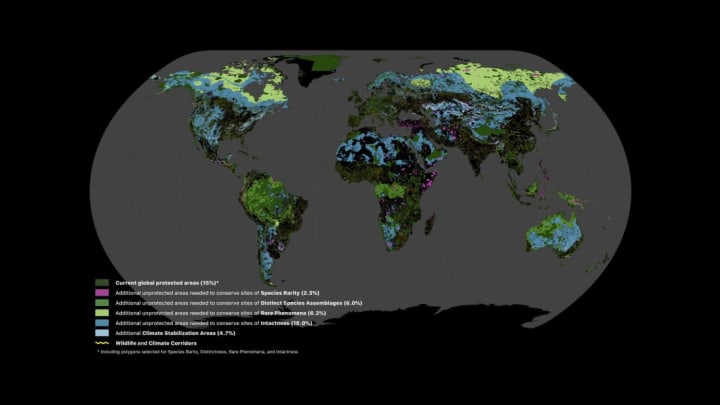Right now, a little over 15 percent of the world’s land comprises national parks and other protected areas that people aren’t allowed to develop. In order to save the planet from the progressively devastating effects of climate change and habitat loss, that number will have to be a lot higher—around 50 percent, according to a new analysis published in Science Advances.
Researchers from RESOLVE, the University of Minnesota, Arizona State University, and Globaïa spent the past two years pinpointing a “Global Safety Net” of the most important regions we must preserve not only to slow climate change, but also to safeguard Earth’s plant and animal species. They split lands into five categories—species rarity sites, high biodiversity areas, large mammal landscapes, intact wilderness areas, and climate stabilization areas—and created an interactive, color-coded map via Google Earth Engine so you can explore them for yourself.
The light blue expanses are climate stabilization areas, which are particularly well-equipped to store carbon. Since humans emit such large quantities of carbon by burning fossil fuels, it’s pivotal that we fortify forests, grasslands, and other terrain that can soak it up before it contributes to global warming. (And, of course, we also need to work on reducing our carbon emissions in the first place.)
High biodiversity areas and rare species sites are dark green and pink, respectively. While protecting Earth’s fascinating flora and fauna is an end goal on its own, there’s another reason why we should keep these ecosystems intact. As humans encroach upon habitats and essentially evict their occupants, we’re increasing our chances of being exposed to new germs. If more diseases make the jump from animals to humans—called zoonotic diseases—it could lead to more pandemics.
The Global Safety Net isn’t only for personal perusal. As Fast Company reports, the researchers are hoping that governments across the globe will use the data to inform future conservation legislation.
“We now have a detailed global map to help guide policy in restoring humanity's relationship with nature,” Google Earth Engine program manager Tanya Birch said in a press release. “By leveraging advanced computer technologies, the Global Safety Net offers an actionable and dynamic roadmap for saving our planet. Technology enables science at scale … and the science is clear, the time to act is now.”
[h/t Fast Company]
